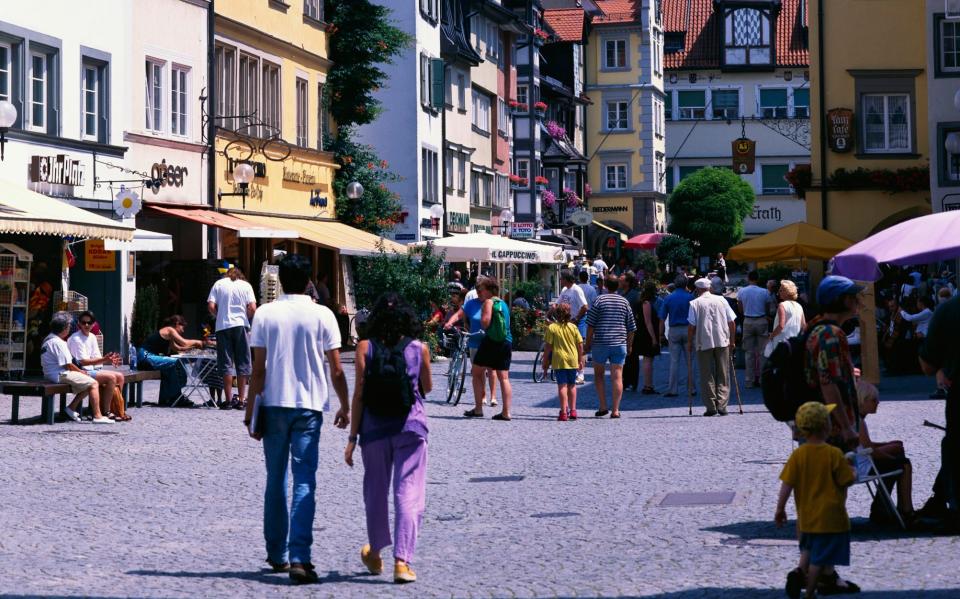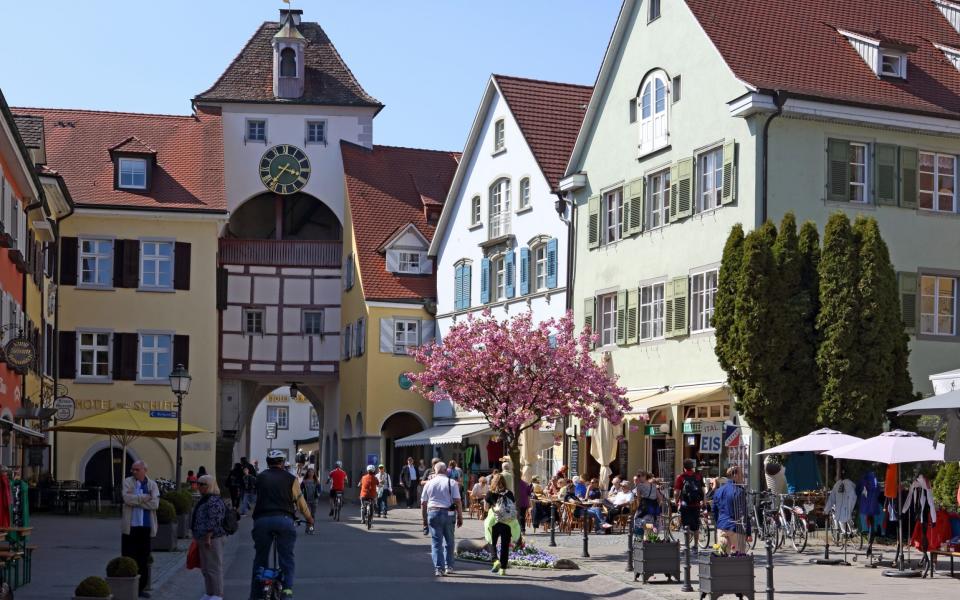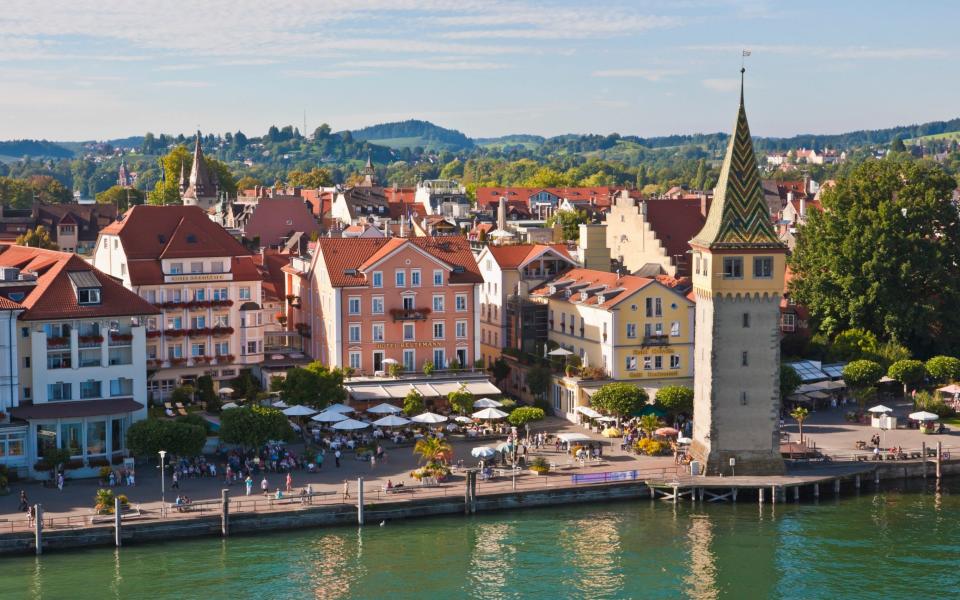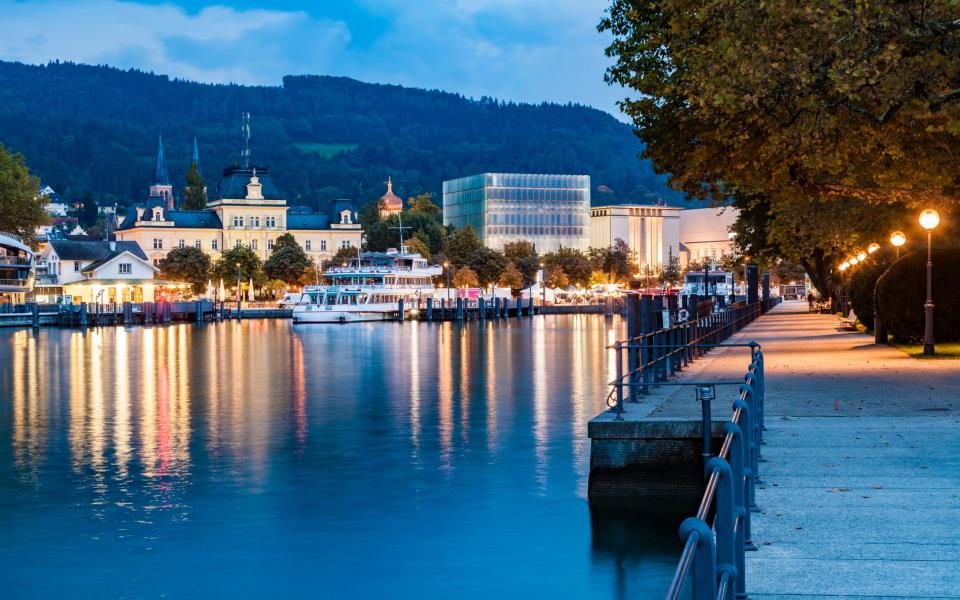The idyllic European lake with fairy-tale towns but hardly any British tourists

It’s 7am on a cold and sunny morning, and I’m sitting in a little boat in the middle of Lake Constance, Central Europe’s largest and loveliest lake. There’s not a cloud in the sky, nor a wave upon the water, but the air is freezing and I’m shivering. Yet right now creature comforts are the last thing on my mind.
In another small boat a few yards away, a jolly German fisherman called Paul Lachenmeier is wrestling with a huge pike, which he’s just hauled out of the water. Its head is writhing to and fro, its sharp teeth flashing in the sunlight. Paul grabs a big stick from the bottom of the boat and hits it on the head three times. Its head flops forward and its body goes limp. Paul tosses it into the crate with all the others and carries on hauling in his nets.
We’re out on the lake for a couple of hours but the time flies by. I lose count of all the fish he’s caught: carp, bream, perch… Not bad going for a few hours work. Paul tells me it doesn’t always go so well. Sometimes he’s out here all morning and returns home with only a few fish to show for it, but today he got lucky, he says, and a broad smile lights up his weatherbeaten face. I’d never make a fisherman, but right now it seems like the best job on earth.
We head back to Paul’s small fishery, on the waterfront in Friedrichshafen, where Angela Katterloher, his partner (in both senses of the word) is making breakfast. Angela hands me a steaming mug of coffee, but all I can think about is food. I don’t have long to wait. We sit outside at trestle tables on the water’s edge, and feast on the perch Paul caught that morning. I’ve never felt so hungry. Fresh fish never tasted so good.
Paul and Angela’s business is called Der Fischkönig (the fish king), but this grandiose title is tongue-in-cheek. They only sell fish they catch themselves, here on the lake, so it’s never going to get much bigger, and it’s all the better for it. You can buy fish here to take home and cook yourself, but a lot of folk prefer to sit and eat it right here on the quayside, looking out across the water, with a few cool beers to wash it down.
Their enterprise encapsulates what I love about Lake Constance. It’s spectacular but unpretentious, dramatic yet authentic. It attracts some tourist traffic, but it’s still a working lake. Although we call it Lake Constance, locals call it the Bodensee (Earth Sea), which feels like a better name by far. This has always been a crossroads at the heart of Europe. Strolling along its leafy banks, the past feels very close. The Romans were here, and the Celts before them. During the Dark Ages its monasteries preserved the wisdom of the Classical World. Even on a sunny day, there’s something powerful and elemental about it. Most of the time it’s fairly tranquil, but if you’re out on the water when the wind picks up it feels like being out at sea.
A huge bulge in the River Rhine, Lake Constance is a border and a thoroughfare between three countries – Germany, Austria and Switzerland – and although it’s popular with German, Swiss and Austrian visitors, most Brits have never heard of it. They don’t know what they’re missing.

Nearly 40 miles long and over eight miles wide, this vast waterway is stunning, and the antique towns along its shores are full of things to see and do. The northern shore is German, the southern shore is Swiss, the eastern end is Austrian, and each part has its own character. The German side has more attractions, the Swiss side is more peaceful, and the Austrian enclave is like a little slice of old Vienna. The road and rail network is very good, but it’s far more fun to travel by boat, on the ferries that criss-cross the lake.
I first came here 30 years ago, during an Interrail trip around Europe with the woman who would become my wife. I’ve lost count of how many times I’ve been back. There’s something new to see here every time. So let me take you on a journey around this enormous lake, across the borders of three countries. It feels like a journey from a hundred years ago.
Six must-visit towns on Lake Constance
Konstanz, Germany
If you’re coming here from Britain, your best bet is to fly to Zurich and take a direct train to Konstanz, the place that gives the lake its English name. This attractive, archaic town is an ideal base. From its ancient harbour you can do day trips by ferry to any of the other towns around the lake.
Konstanz is in Germany, but only just. At the mouth of the River Rhine, the medieval altstadt (old town) is on the south side of the river, surrounded on three sides by Switzerland. The biggest conurbation on the lake, but still small enough to get around on foot, its cobbled streets are lined with smart shops and cafes, and its university gives it a lively, youthful buzz.

Konstanz is full of history, and for a few years, 600 years ago, it became the centre of the western world. At that time Europe had three rival popes, so in 1414 Europe’s cardinals and princes congregated here to pick one they could all agree on. The process took four years, and during that time Konstanz became party central.
Remarkably, the robust building where they met and talked interminably, the Konzilgebäude, is still there, but by all accounts these aristocrats and clerics spent more time whoring than debating, and their lewd behaviour is commemorated by a splendid statue, 30 feet high, which stands at the mouth of the harbour. Made by local sculptor Peter Lenk, it depicts a voluptuous courtesan holding two emaciated little men, a dwarflike pope and a dwarflike emperor, in the palms of her outstretched hands.
Meersburg, Germany
From Konstanz it’s a short ferry ride to Meersburg, the prettiest town on the Bodensee – a cluster of half-timbered houses clinging to a steep hill above the water. Of all the places on the lake, it’s the only one that’s become a tourist trap, but it’s so quaint you’d be mad to miss it. Its skyline is dominated by the Altes Schloss, a medieval castle, and the Neues Schloss, a rococo palace. Both places are worth a visit but you need to get there before the tour groups. Board an early ferry, stop for brunch, and then catch the next boat on to Friedrichshafen.

Friedrichshafen, Germany
Friedrichshafen was the only town on Lake Constance to be bombed by the Allies during the Second World War, on account of its importance as an industrial centre. The postwar buildings that replaced the old ones are rather bland, but don’t let that put you off. Ferdinand von Zeppelin built and flew his eponymous airships here, and the old train station now houses a fascinating museum devoted to this aeronautical pioneer. Look up and you’ll see modern Zeppelins floating silently through the skies above. If your pockets are deep enough (well, deeper than mine) you can take a ride on one, from the small airfield nearby.
Lindau, Germany
Sailing from Friedrichshafen to Lindau, you cross the border between Baden-Württemberg and Bavaria. To anyone outside Germany this may not mean that much, but to Germans it’s almost as significant as the border between England and Scotland. Baden-Württemberg is predominantly Protestant, and its inhabitants have a reputation for thrift and business savvy. Bavaria is Catholic, with a proud tradition of southern European joie de vivre. Even as you step off the boat, you can sense the lighter ambience. This is a town made for merrymaking, the closest thing Bavaria has to seaside.

Built on an island in the lake, linked to the mainland by a narrow causeway, Lindau is almost absurdly picturesque. Winding alleys lined with gingerbread houses make it an enchanting place to wander, but thankfully it still feels like a workaday town rather than a touristic theme park. It’s never short of sightseers, but most visitors are individual travellers, rather than big coach parties. Several thousand people still live here on the island. Last time I came I gatecrashed a fundraising bash at the local fire station (beer and bratwurst, live music). For me, this sort of thing, not guided tours, is what Lindau is all about.
Bregenz, Austria
Another ferry ride, another border crossing, this time from Germany into Austria. Landing here it’s quite clear you’ve entered another country. Despite its compact size there’s a metropolitan grandeur about Bregenz that feels quite different from the other towns around the lake. Ambling along the promenade, I tried to think what it reminded me of, and then I realised: it feels a lot like the Italian city of Trieste. Like Trieste, there’s something surreal, almost dreamlike, about it – the same sense of being in a place apart, a Viennese suburb transported to a foreign shore. Fittingly, for such a theatrical little place, the big attraction every summer is opera on the waterfront, on a stage upon the lake.

Rorschach, Switzerland
Visitors often miss out on the Swiss side of the lake, and to my mind that’s a pity. It’s not as arresting as the German side and the towns are smaller and sleepier, but there’s a discreet charm about this stretch of water which really draws you in. My favourite spot is Rorschach. A friendly, unassuming town, there’s not a great deal to it – just a lovely footpath along the lakeside, and a sleek art gallery with fantastic views across the water.
On a clear day like today you can see the Alps, their snowcapped peaks framed by the clear blue sky above and the clear blue water down below. The lake stretches away as far as you can see. Friedrichshafen is a faint blur on the horizon. Konstanz is far away, out of sight. As I left for home, I wondered what it’d be like to live here. I know it’s just a dream. I know it’ll never happen. But I’ll be back again sometime soon. Maybe next time I’ll see you there.
How to do it
Swiss (swiss.com) flies direct to Zurich from Heathrow, London City, Birmingham and Manchester. EasyJet (easyjet.com) from Gatwick and Luton.
A direct train from Zurich Airport to Konstanz takes just over an hour. A single ticket costs from CHF10.60 (about £8.70). Visit sbb.ch, the website of Swiss Federal Railways, for timetable information and to book.
The best hotel in Konstanz is the Steigenberger Inselhotel Konstanz (steigenberger.com), housed in an old monastery on its own island. Double rooms in June from €184.50 (£157).

The best way to get around Lake Constance and visit the many sights along its shores is to buy a Bodensee Card Plus which gives you unlimited travel on ferries all around the lake, plus free entry to more than 100 local museums and attractions. A three-day pass costs €72 (£61) from bodensee.eu.
A cheaper option is the Bodensee Ticket, from sbb.ch, which gives you unlimited travel on local trains and buses in two zones (ask for East & West zones, not South) but this only includes the car ferries between Konstanz & Meersburg and Friedrichshafen & Romanshorn, not the prettier passenger ferries which ply the other routes. A day ticket costs €22 (£19), a three-day ticket €44 (£38).
A good option if you only have a day to spare is the Tagesticket Uberlinger See (€19.50/£17 from bsb.de) which gives you a day’s unlimited ferry travel on the Uberlingen arm of the lake, including Konstanz, Meersburg and the famous “flower island” of Mainau. Or buy a return ticket from Konstanz to Bregenz (€19.80/£17 each way, also from bsb.de). The ferry stops at numerous lakeside towns en route and you can break your journey as often as you like along the way.
For more information about visiting Lake Constance, go to germany.travel or myswitzerland.com.

